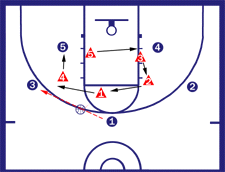
Typically, the one will take the top position. This means moving to a better location to cut off passes and gather rebounds. Players will also shift as the ball is moved to be in better defensive position. They each have their own area to guard on the court. This will help create the most turnovers.Įach player will have their own responsibility in the zone. It is vital for players not guarding the ball handler to anticipate a bad pass or shot in order to make a steal or get a rebound.

Often bad passes and shots are forced out by the player just to get the ball out of the corner. When a player is double teamed without their dribble they tend to make poor decisions. This creates a problem for the offense but is exactly what the defense wants to happen.

If a player is trapped in the corner they tend to stop their dribble before making a decision to pass or shoot. In basketball the ball can only be held for five seconds before passing, shooting, or dribbling. Two defensive players will try to trap the ball handler in one of the corners of the half court. Turnovers within this defense are created by a couple key features of this strategy. This defense focuses extra pressure on the ball handler and will exert more effort to force turnovers. The goal of the 1-3-1 zone defense is to create turnovers.
DEFENSE ZONE BASKETBALL FREE
The five position is posted in the center of the formation at about free throw level. The rover position is typically the best athlete’s position since there is the most area to defend around the basket. The four position is down beneath the basket and acts as a rover along the base line.

The two and three positions are split out on the edges of the court at free throw level, or on the wing. In this formation, the one will take the top and meet the oncoming offensive guard. The center is the tallest player and specializes in close vicinity to the basket. Forwards usually are the most athletic and are typically taller than the guards. Guards are quick and typically are good ball handlers and shooters. One and two are guards, three and four are forwards, and five is the center in a typical basketball lineup. In basketball positions are numbered from one to five. A picture of the formation is shown on the right. It falls under this category because each player guards a specific zone within the formation. The 1-3-1 zone defense is a zone defense. Typically they are divided into man defenses and zone defenses. There are multiple ways to approach defense in the sport of basketball.
DEFENSE ZONE BASKETBALL FULL
One effective press-break against the 1-3-1 full court press is to have either the power forward or the center to flash to midcourt and then quickly pass the weak side guard running down the sideline, not allowing the trap to be formed. The lead guard will pressure the ball in the backcourt, and also can shade over to the side and form a 2-man trap with a defensive player in the 3-set when an offensive guard tries to bring up the ball down the sideline. They usually have two guards to double team the ball carrier.Īnother variation of the 1-3-1 defense is the full court press version. The defensive usage of the 1-3-1 is mostly used to create turnovers, not for protecting the paint, due to only having one player down low. These poor passes are meant to be taken advantage of in this defense so the weak side defenders must anticipate passes to create turnovers.Ī form of this player formation is also sometimes effective in ice hockey, as used by the NHL's Tampa Bay Lightning team in the 21st century, and said to have been pioneered in ice hockey as a form of neutral zone trap by the 1990s-era New Jersey Devils. This often results in poor passes or shots. This trap often forces the ball handler to get rid of the ball prematurely taking the offense out of their set up. The defense attempts to guide the ball handler towards a corner and quickly close in and double team the offensive player creating a trap with the defenders and side lines. A two-man trap is implemented in this defense. This is done by using quick, pestering defense and anticipating any passes to attempt a steal.

The main focus of this defensive strategy is to force turnovers. This defense is named for its formation since there is one defender at the point, three defenders at the free throw level, and one defender at the base line. It was originally utilized by Hall of Fame coach Clair Bee. The 1-3-1 zone defense is a defensive basketball formation.


 0 kommentar(er)
0 kommentar(er)
